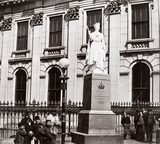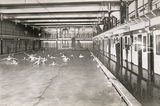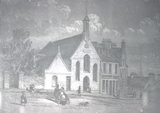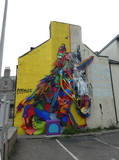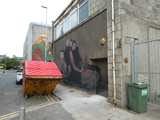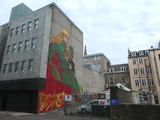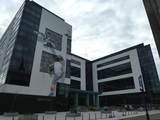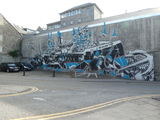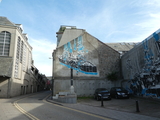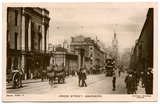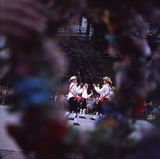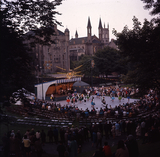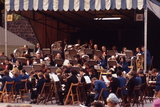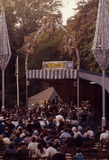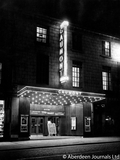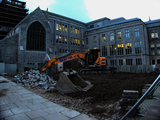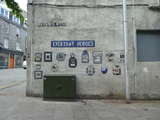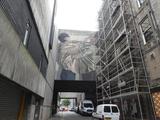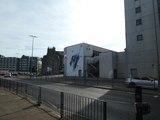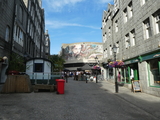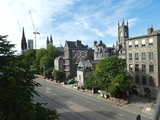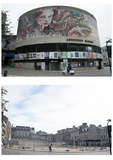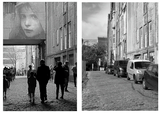|
Quick Search
|
Search Results
You searched for: More Like: 'Alternative Festival Review'
189 items
items as
Statue of Queen Victoria
73 A photograph showing the statue of Queen Victoria at the junction of Union Street and St. Nicholas Street. The building in the background is the Clydesdale Bank that stands next to M&S today. This fine Italian renaissance style building was originally constructed for the Town and County Bank and opened for business in May 1863.
The statue of Queen Victoria was made from marble and was sculpted by Banff born Alexander Brodie (c.1829 - 1867). The origin of this statue is closely related to another Aberdeen monument, the 1863 memorial statue of Prince Albert by Baron Marochetti, now standing, or rather sitting, in the area in front of the Central Library.
Marochetti's statue was augurated by Queen Victoria herself on 13th October 1863 and this was said to the first time the Queen had appeared at a public demonstration following the death of Albert in 1861. The Marochetti statue was the subject of great local controversy and there were various plans for an alternative, superior, memorial to the late Prince Consort. It was at a related meeting that a chap called Alexander Donald, from the Royal Tradesman of Aberdeen, moved "That a colossal statue in marble, of Her Majesty, be erected at the corner of St. Nicholas Street."
The endeavour was taken on by a variety of prominent citizens and funding was raised by public subscription. Brodie, the selected sculptor, worked on an 11-ton block of Sicilian marble for two years to complete the statue. The finished piece is 8 foot 6 inches in height and, at the request of Queen herself, depicts Victoria in Scottish regal attire. The statue stands on a substantial plinth of pink Peterhead granite.
The statue was unveiled and inaugurated on 20th September 1866 by Albert-Edward Prince of Wales, later to be King Edward VII and the subject of another of Aberdeen's notable statues. During his speech at the ceremony, the Prince said "Gentlemen, it has afforded me the greatest satisfaction to attend here today, by the wish of Her Majesty, and at your invitation, for the purpose of inaugurating a statue of the Queen, my dear mother. Her Majesty has desired me to express to you how much she appreciates the motives which have led the people of Aberdeenshire to give this lasting evidence of their attachment and loyalty to her person, of which she has so many proofs, and whose sympathy in her great sorrow has touched her so deeply."
During his visit, the Prince of Wales also received the Freedom of the City and attended the Royal Horticultural Society's Autumn Show, which was then going on in the Music Hall. An extensive account of the unveiling, the Royal visit and the town's celebrations is given in the Aberdeen Journal of 26th September 1866.
After some time at this location, the statue's marble began to show weathering due to the frost and so it was moved to the vestibule of the Town House in 1888, where it remains to this day. It stands at the foot of the building's splendid main stairway. The plaster model of Brodie's statue has also been on display in the Music Hall for many years.
A new bronze statue of an older Victoria, by sculptor Charles Bell Birch, was erected at the St. Nicholas Street location on 9th November 1893 and "the Queen" became a regular meeting place for generations of Aberdonians. To make way for the extension of Marks & Spencer, the 1893 statue moved to its current site at Queen's Cross on 22nd January 1964. Victoria now stands looking east towards Balmoral. Beach Bathing Station
99 The interior of the Beach Bathing Station, where generations of Aberdonians learnt to swim in the fresh water pool. The Bathing Station was designed by City Architect, John Rust, and opened on 13th July 1898. A distinctive red brick chimney dominated the beach skyline. The Bathing Station was eventually filled in and demolished, the door having finally closed to the public on 11th July 1972. Northfield Mission Church and School
1854 Engraving of Northfield Mission Church and School, Gilcomston.
See image A08_03 for an alternative, more complete, version of this image. Nuart 2018: Rustico, Union Row
2733 An artwork created by Portuguese artist Bordalo II for the Nuart 2018 Festival that ran from 12th to 15th April of that year.
The artwork, depicting a colourful unicorn made from end-of-life materials, is on the eastern side of the Italian restaurant Rustico. The restaurant sits at the junction of Summer Street and Union Row. The words next to the Unicorn read "Endangered dream".
This photograph was taken on 10th June 2018. Nuart 2018: Union Row
2734 An artwork by Argentinian artist Milu Correch created for the Nuart 2018 Festival that ran from 12th to 15th April of that year.
The large scale mural is located on the south side of Union Row.
This photograph was taken on 10th June 2018. Nuart 2018: Caledonian House
2735 An artwork by artists Nimi and RH74 created for the Nuart 2018 Festival that ran from 12th to 15th April of that year.
The large scale mural is on the western exterior wall of Caledonian House on Union Row.
This photograph was taken on 10th June 2018. Nuart 2018: Union Plaza
2736 An artwork by Lithuanian-born artist Ernest Zacharevic for the Nuart 2018 Festival that ran from 12th to 15th April of that year.
The artwork is on the south eastern facade of Union Plaza, a large office development in Aberdeen's city centre.
This photograph was taken on 10th June 2018. Nuart 2017: Harriet Street
2758 An artwork by Polish artist M-City for the Nuart 2017 Festival that ran from 14th-16th April of that year.
The artwork is on 18 Harriet Street, located at the junction of Harriet Street and Loch Street.
This photograph looks west and was taken on 14th July 2018. Nuart 2017: Harriet Street
2759 An artwork by Polish artist M-City for the Nuart 2017 Festival that ran from 14th-16th April of that year.
The artwork is on 18 Harriet Street, located at the junction of Harriet Street and Loch Street.
This photograph looks south and was taken on 14th July 2018. Nuart 2017: Belmont Street
2760 An artwork by Italian artist Alice Pasquini for the Nuart 2017 Festival that ran from 14th-16th April of that year. The artwork is mid-way along Belmont Street.
In this image can also be seen the entrance to Shri Bheema's Indian restaurant. This popular establishment opened in 2012 and was followed by a branch in Bridge of Don. Branches in Edinburgh, London and Milton Keynes were later opened.
On the right of the image is the premises that previously housed One Up Records. This shop traded at this location from 1979 to January 2013.
This photograph looks south and was taken on 14th July 2018. Union Street, Aberdeen
2775 A Davidson Bros. "Real Photographic" Series postcard looking east up Union Street. The image likely dates from the early 20th century. Before the junction with Back Wynd can be seen the Queen's Restaurant at 120 Union Street and R. Hunter, Chemist at 118.
The building at the junction of Union Street and Back Wynd was initially built in 1837 to a design by John Smith. It was the first purpose built home of the Society of Advocates in Aberdeen.
Doreathea Bruce, in her history of the Society, explains that they sold the building in 1870 after construction of the the new, James Matthew designed, Advocates' Hall in Concert Court.
The old hall was bought by Lockhart & Salmond, confectioners, and later functioned as a restaurant and as a cinema. Bruce suggests the building became known as Queen's after it was decorated by City Architect John Smith shortly after Victoria's wedding to Prince Albert in 1840.
Her full history of the Society of Advocates in Aberdeen can be read in Aberdeen University Review, LVI, no. 195, Spring 1996. Union Terrace Gardens
3112 A photograph of a well attended public event in Union Terrace Gardens, featuring morris dancing, in 1970. This is most like during the Aberdeen Festival that was held in June of that year.
This photograph comes from a collection of slides donated to Aberdeen City Libraries by Aberdeen City Council's publicity department. Union Terrace Gardens
3113 Country dancing at a well-attended public event in Union Terrace Gardens in 1970. This may have been part of a festival or a regular programme of entertainment.
The rear of the Belmont Cinema building and the Belmont Congregational Church are visible in the background.
This photograph comes from a collection of slides donated to Aberdeen City Libraries by Aberdeen City Council's publicity department. Union Terrace Gardens
3119 A brass band during a public event in Union Terrace Gardens. This was likely an evening event during the Aberdeen Festival held in June 1970.
This photograph comes from a collection of slides donated to Aberdeen City Libraries by Aberdeen City Council's publicity department. Union Terrace Gardens
3120 A brass band, and its audience, during a public event in Union Terrace Gardens. This was likely a evening event during the Aberdeen Festival held in June 1970.
This photograph comes from a collection of slides donated to Aberdeen City Libraries by Aberdeen City Council's publicity department. Aberdeen Cinemas: Picture House / Gaumont
3404 Silver Screen in the Silver City (1988) by Michael Thomson explains that by 1950 the Picture House was owned by the Rank Organisation. The British entertainment conglomerate had acquired various cinema exhibition companies: British-Gaumont, Odeon, and the Provincial Cinematograph Theatres (successor company to Associated Provincial Picture Houses). As part of business rationalisation, on 22nd March 1950 the Picture House was rebranded as The Gaumont.
Thomson's Silver Screen indicates that the Gaumont's vertical neon sign dates from the time of the rebranding. In 1956 the design of the cinema was further updated. This saw the introduction of the illuminated canopy and use of the beech design shown here in the redeveloped interior and exterior, replacing the pillars of the Picture House era. A new marble backed fireplace replaced the old one that had been a well-known feature of the cinema since its opening in 1914. The projection equipment and seating were also modernised. This night-time image from the Aberdeen Journals Archive accompanied an article about the Gaumont's new look in the Evening Express of 19th April 1956.
The image shows promotion for a number of films on the cinema's updated exterior: The Rose Tattoo with Burt Lancaster and Anna Magnani, Flight from Vienna and Aberdeen Photographic Service's presentation of A Photographic Review of the Royal Tour of Nigeria.
The manager at the time of the Gaumont's redesign was Mr. R. E. Miller. He had managed the cinema since January 1948. In early 1951 Miller converted the upstairs restaurant area, which had laid empty since 1928, into a gallery space. Known as the Gaumont Gallery, it was ideal for photographic exhibitions and was in frequent use well into the 1960s.
Thomson states that during this period Mary Garden, the retired opera singer who returned to Aberdeen in 1939, was something of a regular at the Gaumont. This well-known and much-loved figure would be escorted to her seat by the cinema's commissionaire George Repper, who was also a popular and familiar figure. Repper worked at the Gaumont from 1940 to 1964 and his job was to shepherd queues, attend to patrons and ensure all progressed smoothly.
[Information primarily sourced from Silver Screen in the Silver City (1988) by Michael Thomson]
Image © Aberdeen Journals Ltd. Site of McKay's
3498 A photograph from 24th February 2021 showing the cleared former site of McKay's clothing shop at 29-31 Queen Street. The business relocated to new premises at 251-253 Great Northern Road in early 2020.
The Queen Street site was sold to Aberdeen City Council in 2019. The building was demolished in the early months of 2021 as a preliminary stage of the authority's Queen Street regeneration project.
The £150 million transformation includes plans for 300 new homes, a civic hub, cultural assets, enhanced heritage features and a high-quality public realm.
McKay's opened their two-floor premises on Queen Street on 25th March 1971. The family business, which has been on the go since the early 20th century, had previously occupied two other locations on Queen Street. The latter Queen Street premises was famous for its abundant and varied stock.
The eastern exterior wall of the building was the site of a large mural depicting a golfer by Norwegian artist Martin Whatson. This was created for Aberdeen's first Nuart festival in 2017 and sadly had to be demolished along with the building.
The rear of A. Marshall Mackenzie's Greyfriars Church of 1903 can be seen on the left of this image. Nuart 2018: Rennie's Wynd
3768 An artwork by Carrie Reichart for the Nuart 2018 Festival that ran from 12th to 15th April of that year. The work, as the name suggests, celebrates everyday heroes past and present and was installed in April 2018. Local artist Shelagh Swanson created the plaques for the work.
The artwork is shown here on Rennie's Wynd at its junction with the Green. Everyday Heroes was relocated to Flourmill Lane in 2019 and was expanded to include six extra heroes in early 2020.
This photograph was taken in July 2018. Nuart 2018: East Green
3771 An artwork created by Argentinian artist Hyuro for the Nuart 2018 Festival that ran from 12th to 15th April of that year.
The artwork, depicting two boys fighting and with their shirts attached together, is on the eastern side of one of the walkways connecting the Indoor Market and Union Street.
This photograph was taken in July 2018. Nuart 2018: Shiprow
3772 An artwork created by UK artist Snik for the Nuart 2018 Festival that ran from 12th to 15th April of that year.
The artwork faces the harbour on the southern elevation of Pure Gym, at the bottom of Shiprow.
This photograph was taken in July 2018. Nuart 2017: The Green
3773 An artwork by German artists Herakut for the Nuart 2017 Festival that ran from 14th-16th April of that year.
The artwork is on the western, curved façade of the Indoor Market in the Green.
This photograph looks east and was taken on 14th July 2018. A food and drink festival is also shown taking place. Nuart 2017: Belmont Street
3774 An artwork by Portuguese artist Add Fuel for the Nuart 2017 Festival that ran from 14th-16th April of that year.
The artwork is on southern side of 15-17 Belmont Street. This photograph, taken on 14th July 2018, looks north from Union Bridge. Denburn Road is the street below. Aberdeen Market: before and after demolition 4
4363 Looking east, the before image shows the Green side of Aberdeen Market. A mural by artists Jasmin Siddiqui and Falk Lehmann (known collectively as Herakut) created for the 2017 Nuart Festival is prominently shown. Taken on 27/08/2021.
The after image provides an extensive view of the cleared site. The gradient of Market Street, with Carnegie's Brae at the end of the East Green, is shown. As are the remains of connections between the 1970s market and Union Street on the left. Taken on 07/09/2023.
This composite image is part of a series by Roddy Millar showing Aberdeen Market and its surrounds before and after it was demolished.
Aberdeen Market: before and after demolition 8
4367 Looking west, the before image shows a number of people inspecting street artwork from the 2017 Nuart Festival. In the top left, on a connecting passageway over the East Green, is a mural by French artist Julien de Casabianca. Taken on 15/04/2017.
The after image is a less populated scene. The tree, possibly a pin cherry, now has its late summer foliage. The top of an artwork by Smug, Australian artist Sam Bates, dating from the 2019 Nuart Festival, can be seen in the distance on part of the Trinity Centre building. Taken on 25/09/2023.
This composite image is part of a series by Roddy Millar showing Aberdeen Market and its surrounds before and after it was demolished. |



